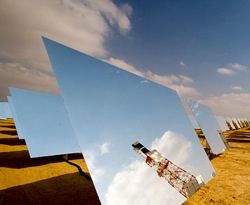
Prepare for a solar building boom in the deserts of Southern California. After spending years in the environmental review process and clearing other bureaucratic hurdles, approvals for clean energy producers are picking up steam.
State regulators have now given the green light to four major solar power projects in as many weeks. The most recent was on Wednesday, when the California Energy Commission gave the nod to a 370-megawatt solar-thermal array known as the Ivanpah project (the CEC does not have authority over photovoltaic or “PV” solar arrays). Developed by Oakland-based BrightSource Energy and built by Bechtel Corp., it will consume more than 3,500 acres near the California-Nevada border, in the northern Mojave Desert.
In recent weeks the CEC has also approved applications for three other projects in Kern, Riverside and San Bernardino Counties. The four projects combined will be rated to deliver almost 1,900 megawatts of power, or the equivalent of two typical commercial nuclear reactors (an important distinction being that nukes run 24/7, while solar plants generate power about 14 hours a day). Projects representing about 1,000 more MW of solar-thermal energy come up for final decision before the end of the month.
BrightSource CEO John Woolard told me that after more than three years in the review process, the wait was worth it.
“Ultimately I think the process works,” Woolard told me in a brief interview after the CEC’s approval of Ivanpah. “Hopefully it’ll work faster or more expeditiously for people behind us. But I can tell you that it’s the most through and complete process I’ve ever gone through.”
Not thorough enough for some environmental groups, it would seem. At the final hearing, Eileen Anderson of the Center for Biological Diversity called it “a sad day.” Her ally Barbara Boyle, at the Sierra Club, agreed.
“We’ve been spending countless hours meeting with developers and with the agencies to try and site these projects right,” Boyle told me.
“We’re working real hard to make that process better in the future but for right now we have quite a few projects that are going to have serious local impacts and it’s disappointing,” she said. Boyle said she thought environmentalists had a deal with BrightSource to shift some of the solar arrays away from sensitive habitat for rare plants and the threatened desert tortoise–but were disappointed that the company didn’t change its original layout after all (though at one point in the process the project was downsized by nearly 500 acres).
Energy Commissioner Jeff Byron concedes that Ivanpah will have some “significant impacts” on the environment but that those will be outweighed by the benefits.
“Southern California–the desert, the Mojave, represents the Saudi Arabia of renewable energy,” said Byron. “There’s geothermal, wind and solar there, so–this is a start. It’s a substantial start.”
State regulators are under pressure to meet a goal to get one third of the state’s electricity from renewable sources, within 10 years. The state’s Air Resources Board is likely to issue its own regulation this week, making that goal a legal mandate for utilities.
4 thoughts on “California: The “Solar Saudi Arabia””
Comments are closed.

You got one thing right: “It [the Ivanpah solar project] will consume more than 3,500 acres near the California-Nevada border, in the northern Mojave Desert.” We need solar installed where the land is already “consumed” by buildings, for example, not land in its natural state
What a disgrace. In our greed we’re going to pave our agricultural land and pristine open space that is habitat to sensitive species in solar panels rather then developing rooftops, brown fields and designated CREZ zones first.
This is a victory for big energy, who wants the populace to believe they need a utility company to control energy output. Instead, we should demand our government invest in distributed power systems that put energy generation into the hands of the people.
Great — now we will power over the last remaining natural landscape — and have “solar malls” – why not use the glass highway design that has been developed and let the roads general the power. And, if the geoengineering aerosol spray planes keep making clouds that block the sun… what then? Still no power! We better think about saving the earth and sky first…